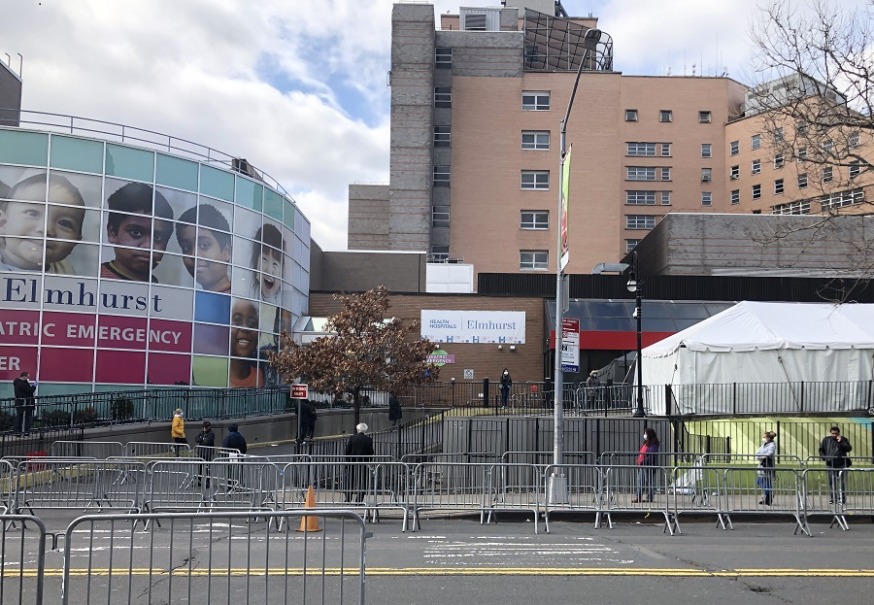
Elmhurst Hospital (QueensPost)
April 7, 2020 By Allie Griffin
The Corona section of Queens is one of the many hot spots across the five boroughs where the COVID-19 pandemic has taken a hold, according to the latest neighborhood data released by the Department of Health.
Three main epicenters have emerged — with one in the Borough Park section of Brooklyn; another in the Norwood neighborhood in the Bronx; and the third being the greater Corona area in Queens.
Corona remains the hardest hit zip code with 1,446 residents having tested positive through to the end of Sunday, when the city last gave a breakdown by zip code. However, the second highest was in Borough Park, where 1,136 residents had tested positive.
Ground zero for the virus continues to be the greater Corona area — with Elmhurst accounting for 963 cases and Jackson Heights 806.
However, the Brooklyn neighborhoods such as Borough Park, where large Hasidic and orthodox Jewish communities live, are close rivals.
For instance, the area adjacent to Borough Park is Midwood, where 946 residents have contracted the virus, according to the latest data from Sunday. Additionally, 789 Bensonhurst residents have tested positive.
In Williamsburg, 859 residents have been infected, according to the data.
Many residents in these neighborhoods of Brooklyn have been subject to criticism. In the past week, the NYPD has had to break up a number of orthodox Jewish funerals, as residents disobeyed the social distancing order.
The Bronx has its own epicenter in the 10467 zip code which covers parts of Olinville, Norwood and Allerton — 941 residents there have contracted COVID-19. Nearby East Bronx accounted for 795 infections.
Many other neighborhoods in each of the boroughs reported upwards of 600 or 700 cases of the total 64,955 cases citywide confirmed as of 5 p.m. on April 5 — the latest zip code data available.
The total cases has since swollen to 72,324 Tuesday morning.
The Health Department first released a zip code breakdown of cases last week after repeated requests from the media and the public.
The data, however, is imperfect — since about 7.5 percent of the people who tested positive for the virus were listed as having an unknown zip code. City Hall didn’t immediately respond to a question asking why the number of unknowns is so high.
The City has also not released the ethnic and racial data on coronavirus cases, hospitalizations and deaths. However, the mayor said that data would be released this week.
The map by zip code shows that low-income areas — particularly communities of color — have been impacted the greatest by the virus.
The data, for example, on the Rockaway Peninsula reflects that.
Far Rockaway — where 21.4 percent of the largely Black and Hispanic population lives below the poverty line — has 713 COVID-19 cases. Conversely, Breezy Point, on the western portion of the Rockways— where just 3.1 percent of the largely white population lives below the poverty line — has only 34 confirmed cases.
Likewise, Corona, the hardest hit community, is mostly Hispanic (75 percent) and more than 20 percent of its population lives below the poverty live.
Mayor Bill de Blasio said the map shows that there is a health disparity in coronavirus cases. He agreed that low-income minority communities are impacted at a greater rate.
“This disease is affecting people disproportionately in lower income communities, in communities that have had more health problems historically and in communities of color,” de Blasio said at a press conference this morning. “The extent of that disparity we are still trying to understand.”
He said the City will release the ethnicity data this week, which will give a better idea of the disparities.
“There is no question in my mind,” he said. “There is a disparity dynamic here, it is real, it is meaningful.”
3 Comments

Stop blaming people and ethnicities for the way the system works. I blame hospitals including ambulances for the way they are set up. I know that when i was sick the first thing EMT asked me was what type of insurance i had. They immediately told me they were going to take me to elmhurst and an argument began when i refused. It was not until my specialists doctor got involved after i called him that they took me to Manhattan. I have an illness and most of my doctors are affiliated with a certain city hospital. EMT did not care even though the time riding in the ambulance would of been the same to either hospital.
People that had mild enough symptoms to ride it out at home were likely not even tested. The only way we’ll ever know how many had it and recovered is when the antibody tests are given.
Close knit communities with their own customs. Word needs to get out that this is not a joke – and it needs to get out in several languages.